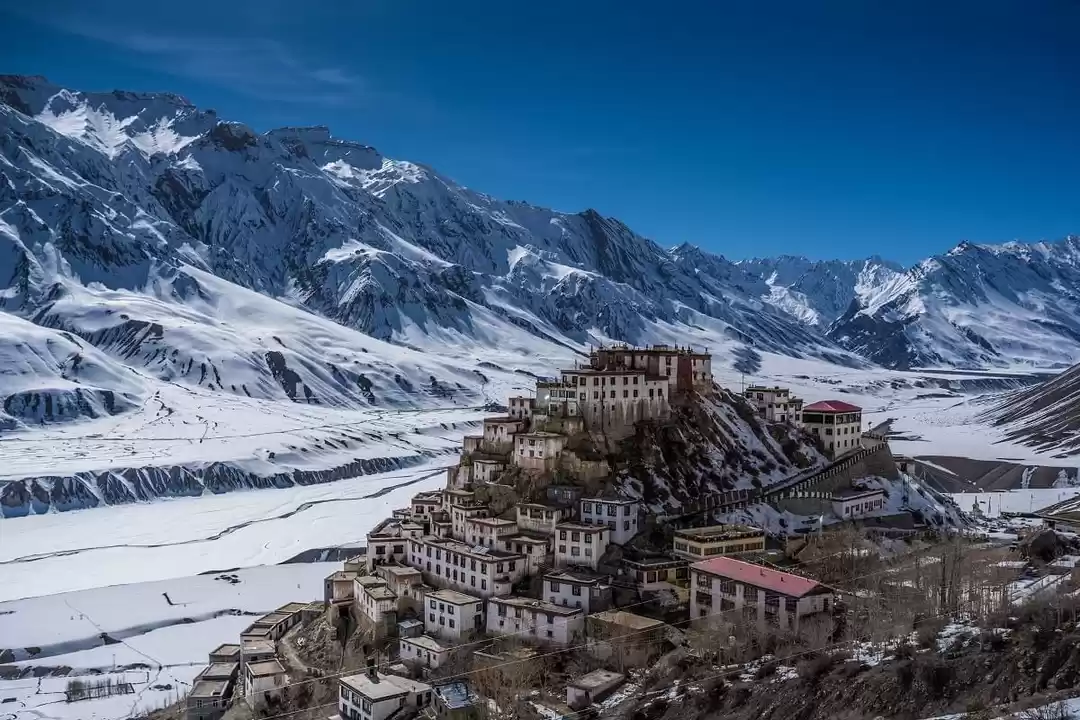- Home
- Holiday Ideas
-
-
- Choose Your Traveling Theme
-
- Adventure Tourism
-
- Cultural Tourism
-
- Tour Packages
-
-
- Packages by State
-
- Holidays by Interest
-
- Popular Tour Packages
-
- Fair And Festivals
-
- Ayurveda And Yoga
-
- Offers
-
- Destinations
-
Spiti Valley
Spirituality in nature’s lap
Spiti Valley
A picturesque paradise echoing with tranquillity and spirituality, Spiti Valley is home to many Buddhist monasteries and stunning natural sites, most of which are unexplored and hence, unspoilt. Snuggled in Himachal Pradesh, the valley boasts a jagged landscape that’s cut by the pristine and fast-flowing Spiti river, gushing through deep gorges and valleys. The river is extremely popular among water sports enthusiasts, especially for river rafting. the luxurious and emerald landscape of the valley, surrounded by snow-capped mountains, is right for lovers of adventure-sports like trekking, paragliding and camping.
...Spiti is usually mentioned as Little Tibet because its terrain, vegetation and climate are very almost like that of Tibet. it’s perched at a height of two ,745 m above water level and is surrounded by Lahaul, Ladakh, Kinnaur and Kullu. From Lahaul, one can enter into Spiti Valley via the Kumzum La or Kumzum Pass, which is found at a height of 14,931 ft.
Read MoreHow to get there
By Air
One can take a flight to Manali or Shimla to reach Spiti Valley. There are direct flights from Delhi, Chandigarh and Kullu to Shimla. From Manali, one can take a bus or taxi to Kaza.
By Road
The nearest railway station is Jogindernagar. The nearest broad gauge railway stations are Chandigarh and Shimla. One can take a bus or a taxi to Spiti Valley from these two cities.
Rail
There is a motorable road from Shimla via Kinnaur to Kaza, which is open for around eight months in a year. From Manali to Kaza, the buses ply from July to October.
Attractions

Spiti Valley Spirituality in nature’s lap
A picturesque paradise echoing with tranquillity and spirituality, Spiti Valley is home to many Buddhist monasteries and stunning natural sites, most of which are unexplored and hence, unspoilt. Snuggled in Himachal Pradesh, the valley boasts a jagged landscape that’s cut by the pristine and fast-flowing Spiti river, gushing through deep gorges and valleys. The river is extremely popular among water sports enthusiasts, especially for river rafting. the luxurious and emerald landscape of the valley, surrounded by snow-capped mountains, is right for lovers of adventure-sports like trekking, paragliding and camping.
Spiti is usually mentioned as Little Tibet because its terrain, vegetation and climate are very almost like that of Tibet. it’s perched at a height of two ,745 m above water level and is surrounded by Lahaul, Ladakh, Kinnaur and Kullu. From Lahaul, one can enter into Spiti Valley via the Kumzum La or Kumzum Pass, which is found at a height of 14,931 ft.
Ki (Kye, Kee) Monastery
One of the most important monasteries in Spiti Valley, located at a height of 4,166 m above water level , the charming Ki Monastery is a stimulating addition to any spiritual traveller’s bucket list. This serene Buddhist site houses many beautiful murals, paintings and stucco images, which are stunning samples of 14th century monastic architecture and leave visitors in awe of their splendour. Alongside, there are unusual wind instruments that are used as a part of the orchestra whenever the chham (masked and costume dance) dance is performed. One also can see a gorgeous collection of weapons, which can have are available use whenever the monastery was attacked by marauders. The Kalchakra ceremony was performed here by His Holiness the Dalai Lama in August 2000. This prayer is organised on a grand scale with an aim to awaken Buddha nature of every individual, employing a combination of prayer, teaching, blessing, devotion, mantra, yoga and meditation. it’s essentially an enquiry for peace. Many believe that albeit one is just present at this initiation ceremony that lasts for a couple of days, one are often freed from suffering and gain enlightenment. There are five main subjects focused – cosmology, psycho-physiology, initiation, sadhana (study) and attaining Buddhahood.
The monastery is sprawled over an enormous area and has many rooms connected by a maze of corridors. a number of the parts are three-storeys-high. This gompa, as monasteries also are called, was used both as a monastery and a fort, and it’s believed to possess been built by Dromton (1008–1064 AD), a lover of Buddhist master Atisa. No date has been ascribed to the time it had been built. Today, many lamas undergo religious training here.


Tabo
This seemingly dull village of mud huts holds beautiful attractions. it’s situated during a bowl-shaped flat valley with the Tabo Monastery lying at rock bottom of the valley, unlike other monasteries which are usually perched atop hills. One will find galleries of wall paintings and stucco statues here, earning it the title of ‘Ajanta of the Himalaya’, inspired by the Maharashtrian destination which has caves filled with art. Founded in 996 AD, Tabo is that the largest monastic complex in Spiti Valley. Also called Tabo Chos-Kor Monastery, it’s said to possess been founded by the Tibetan Buddhist Iotsawa (translator) Rinchen Zangpo on behalf of Yeshe-O, the king of Guge within the western Himalayas.
It boasts nine temples, 23 chortens, and chambers for monks and nuns. Besides, it’s many caves carved into the cliff face where monks wont to meditate. Alongside are some contemporary structures. One also will find thangkas or scroll paintings and manuscripts here. For Himalayan Buddhists, Tabo is second to Tibet’s Tholing Monastery in terms of its religious sanctity. Several Indian pundits have, over the years, visited the Tabo monastery to find out Tibetan language. After the earthquake in 1975, the monastery had to be rebuilt and a replacement auditorium or Du-kang was also constructed. The Kalchakra ceremonies, a process of initiation and rejuvenation, in 1983 and 1996 were held here by the 14th Dalai Lama . it’s being protected by the Archaeological Survey of India (ASI) as a national historic treasure and therefore the ASI encourages heritage tourism to the Tabo Monastery.
Kibber
Lying at a height of 4,205 m above the ocean level, the mountainous village of Kibber is understood for its natural beauty and monasteries. Many say that the landscape of Kibber resembles that of Tibet and Ladakh and thus its beauty lies in its barren splendour. The famous Ki Monastery, which is that the largest monastery within the valley, lies very on the brink of the village that’s a base for several high-altitude treks. Another attraction is that the Kibber Sanctuary that lies a touch beyond the village and is cover a 1,400 sq km area. This sanctuary is that the just one in India that’s located during a cold desert and one can find blue sheep and ibex here. Kibber is additionally one among the foremost fossiliferous (containing fossils or organic remains) regions within the country and an excellent place to find out about history. Kibber wont to be the very best village within the region and was permanently inhabited and connected by a motorable road.


Losar
The first inhabited village of the world , Losar lies where the Losar and Peeno streams meet. it’s situated at a height of 4,080 m above water level . This village is found adjacent to the Indo-Chinese border and is that the extreme end of the valley, its landscape considerably resembling that of Ladakh. Towering and delightful mountains, picturesque rivers and lovely vistas make Losar a must-visit destination for nature-lovers.
Though it’s unexplored, the village has shops, schools, a post office and a health centre, serving to the convenience of these visiting it. Another attraction nearby is that the Chandratal or the Moon Lake, where one can get even more lovely views. to succeed in the moon lake, one has got to cross the Kunzum Pass. the simplest time to go to Losar is between July and September.
WANT TO RENT A CAR IN INDIA ?
Choose Your Traveling Theme

 TOUR BOOKING
TOUR BOOKING















